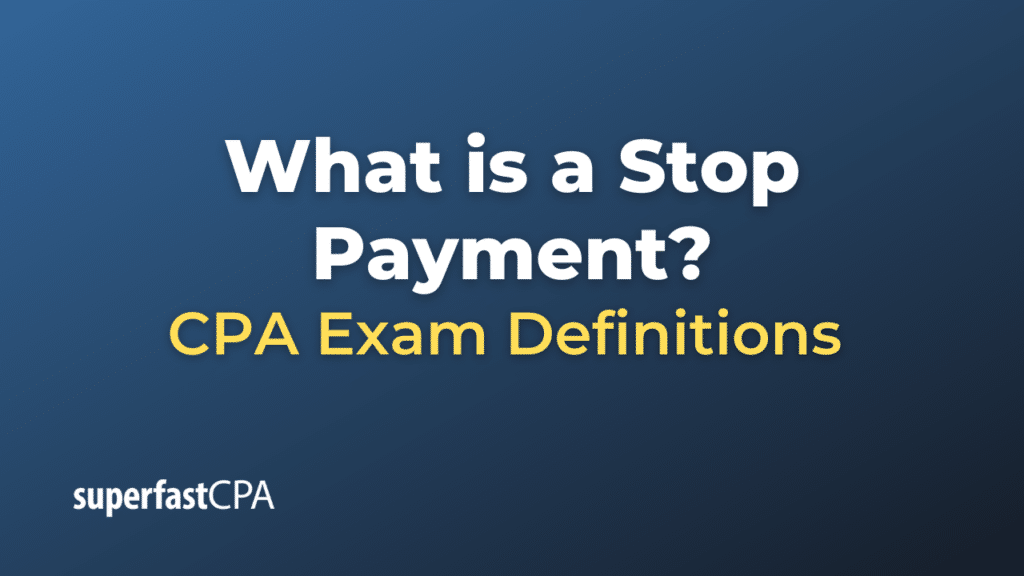Stop Payment
A “stop payment” is an instruction given by an account holder to their bank to cancel (or “stop”) the payment on a check or pre-authorized electronic payment that they have issued but has not yet been processed. By issuing a stop payment, the account holder prevents the check or electronic payment from being withdrawn from their account.
Reasons someone might issue a stop payment include:
- Lost or Stolen Checks: If an account holder loses a check or believes it to have been stolen, they may issue a stop payment to prevent any potential fraudulent activity.
- Disputes: If there’s a disagreement between the account holder and the payee regarding goods or services that were to be provided, the account holder might stop the payment until the dispute is resolved.
- Errors: If an account holder realizes they’ve made an error on a check (e.g., wrong date, wrong amount), they might use a stop payment to prevent it from being cashed.
- Prevent Overdraft: If someone realizes they won’t have enough funds to cover a check they’ve issued, they may decide to stop the payment to avoid overdraft fees and negative account balances.
- Cancellation of Regular Payments: If someone has set up automatic recurring payments (e.g., for a subscription service) and decides to cancel or change the service, they might issue a stop payment if the service provider doesn’t process the cancellation in time.
Some important points to consider with stop payments:
- Fees: Banks usually charge a fee for issuing a stop payment. This fee can vary depending on the bank and the type of account.
- Temporary: A stop payment is not permanent. It usually lasts for six months, after which the check or payment can be processed unless the stop payment is renewed.
- Not Always Guaranteed: A stop payment can usually prevent the check or payment from being processed, but it’s not a 100% guarantee. For instance, if the check has already been cashed, the stop payment will not be effective.
- Potential Legal Implications: Issuing a stop payment does not absolve someone of the legal obligation to pay a legitimate debt. If the payment was for a valid debt or purchase, the payee can still seek payment through other means, potentially including legal action.
It’s always a good idea for individuals to communicate with the payee and their bank when considering a stop payment to understand potential implications and ensure the process is handled correctly.
Example of a Stop Payment
Let’s walk through a fictional scenario to illustrate how a stop payment might be utilized.
Scenario: Anna and the Custom-made Dress
Background:
Anna ordered a custom-made dress from “Elegant Designs,” a boutique dressmaker. The total cost was $500. Once the dress was ready, she wrote a check for the full amount and mailed it to the dressmaker. However, upon receiving and trying on the dress, Anna found significant discrepancies between what she had ordered and the dress she received.
Situation:
- Disappointment and Communication: Anna was disappointed to find that the color and design of the dress varied considerably from her order. She immediately called “Elegant Designs” to discuss the issue. The dressmaker insisted that the dress was made according to Anna’s specifications and refused a refund or alteration.
- Decision to Stop Payment: Given the disagreement and the dressmaker’s unwillingness to provide a resolution, Anna decided to stop the payment on the check she had mailed. She was concerned that “Elegant Designs” would deposit the check before they could reach a mutual agreement.
- Bank Visit: Anna went to her bank the next morning and requested a stop payment on the check. The bank representative informed her of the fee associated with this service ($30 in this case). Anna agreed, considering it was a smaller amount than potentially losing the full $500.
- Outcome: A few days later, “Elegant Designs” attempted to deposit Anna’s check. Due to the stop payment, the check was not honored, and the payment was not processed. The dressmaker contacted Anna, expressing frustration about the declined check.
- Resolution: After some negotiation, “Elegant Designs” agreed to make necessary alterations to the dress to better match Anna’s original request. In return, Anna agreed to send a new check once she was satisfied with the alterations.
This example demonstrates how a stop payment can be a tool for consumers to manage disputes and protect their funds. However, it’s essential to remember that a stop payment doesn’t erase the obligation to pay for a product or service, and open communication is always crucial in such situations.













